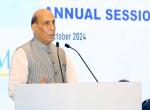Last week, Vikramaditya, formerly Adm. Gorshkov, a 45,000-tonne displacement aircraft carrier built in Russia began its sea trials, six months before it is handed over to the Indian Navy on December 4, the Navy Day.
This week, four frontline warships are on a port call in Shanghai at the end of a sustained overseas deployment as part of India’s ‘Look East Policy’. The four IN ships, Rana, Shivalik, Karmukh and Shakti, under the command of Rear Admiral P Ajit Kumar, Flag Officer Commanding Eastern Fleet are on an operational deployment to the South China Sea and North West Pacific. Earlier in the deployment, the first bi-lateral maritime exercise between India and Japan 'JIMEX 12' (Japan India Maritime Exercise) was conducted, coinciding with commemoration of 60 years of diplomatic relations between India and Japan.
According to the Indian Navy even as the four ships of the Eastern Fleet are in the South China Sea, another ship, INS Savitri is currently in Port Victoria, Seychelles. INS Savitri will participate in the National Day celebrations of Seychelles and thereafter be deployed for about two months to undertake surveillance of the Exclusive Economic Zones (EEZ) of Seychelles and Mauritius. The Indian Navy continues to maintain one Dornier aircraft in Seychelles to provide aerial surveillance for the Seychelles EEZ. Another Dornier aircraft is actively flying from Maldives to meet Maldivian requirements of EEZ surveillance and anti-piracy patrols.
INS Tabar is on a sustained deployment in the Gulf of Aden on convoy escort and anti-piracy patrol.
Four ships of the Western Fleet have just begun on an overseas deployment to Horn of Africa, Red Sea and the Western Mediterranean under the command of Rear Admiral AR Karve, Flag Officer Commanding, and Western Fleet.
Suddenly, the Indian Navy is the service to watch out for.
Quietly, it has gathered pace in acquisition and modernisation together. Currently it is in the middle of a planned expansion designed to cater to emerging maritime security challenges in the Indian Ocean Region and beyond.
For instance, in April, India’s latest naval base, INS Dweeprakshak (Island protector) was put into operation at Kavaratti in Lakshawadeep, the tiny island chain, southwest Kerala. Although the Indian Navy has had a small presence on the strategically important islands for the past decade, its decision to open a permanent base emanated from recent incidents of piracy very close to these islands. At least 100 pirates were caught and several piracy attempts foiled in the vicinity by the Indian Navy in recent times.
In a statement, the Navy said: “Indian Navy has been operating a detachment at Kavaratti since early eighties. With the commissioning of INS Dweeprakshak, the island territories would see calibrated strengthening of assets in step with their growing relevance to the security calculus of the Nation. A firmer footing in the islands, which are spread out astride some of the busiest shipping lanes of the world would provide the necessary wherewithal to the Indian Navy to discharge its responsibilities suitably. Indian Naval Warships on patrol would now extend their reach farther with base support from INS Dweeprakshak.”
The establishment of this base is in keeping with the announcement made by the Chief of Naval Staff, Adm. Nirmal Verma. “The Navy is also in the process of setting up Operational Turn Around (OTR) bases, Forward Operating Bases and Naval Air Enclaves along the coast which would enhance the reach and sustainability of our surveillance effort. ..in 2011the Navy has provided a renewed impetus and focus towards creation of operational and administrative infrastructure in the Andaman and Nicobar Islands and the Lakshadweep and Minicoy Islands. These islands are the country’s strategic outposts and augmentation of the facilities would enhance our reach and enable extended presence in the area,” he had said in December2011.
The Navy’s long-term Maritime Capabilities Perspective Planning fact has identified a mix of two major roles for the force: One, the traditional blue water operational capability and two, a plan to effectively counter threats closer to the coast.
According to the report of the Standing Committee on Defence, tabled in Parliament in the last week of April, the Navy’s short-term plan has the following objectives:
- Augment airborne maritime surveillance, strike, Anti Submarine Warfare and air defence capability through induction of shore-based aircraft, integral helos, carrier based aircraft, space based AIS and UAVs, along with suitable weapons and sensors
- Build adequate standoff capability for sea lift and Expeditionary Operations to achieve desired power projection force levels, influence events ashore and undertake Military Operations Other Than War.
- Induct assets and develop suitable infrastructure to augment forces available for Low Intensity Maritime Operations (LIMO), protection of off- shore assets and Coastal Security framework.
- Induct force multipliers like satellite based global communications, reconnaissance and network enabled platforms to achieve Battle-Space dominance capability and perform network centric operations.
- Induct state-of-the-art equipment and specialised platforms for Special Forces to enhance niche capabilities to conduct Maritime Intervention Operations and other envisaged roles.
- Develop support infrastructure in island territories to support the planned force levels as well as support infrastructure for ships/submarines/aircrafts at ports and airbases.
Given the extensive plans presented to the Parliament, it is evident now that the Indian Navy is in the middle of its most ambitious expansion plan in the past three decades. Senior officers point out that the Indian Navy’s perspective-planning in terms of ‘force-levels’ is now driven by a conceptual shift from ‘numbers’ of platforms -- that is, from the old ‘bean-counting’ philosophy -- to one that concentrates upon ‘capabilities’.
Naval HQ says 50 modern ships are currently on order with majority being built Indian shipyards. The Parliament’s Standing Committee on Defence was informed last month that while Indian shipyards have made remarkable progress in building hulls and associated equipment but still lag behind in building and manufacturing weapons and sensors.
Traditionally the Indian Navy has sourced most of its ships from the former Soviet Union but over the past decade, defence planners have leaned hard on Indian shipbuilding yards to deliver a variety of warship for the Indian Navy.
Two stealth ships—INS Shivalik and INS Satpura-- commissioned recently have been designed and built by public sector Mazgaon Docks Limited. The order books of India’s oldest government-owned shipbuilders are full with the Navy wanting four more such guided missile frigates over the next five years.
There are more acquisitions in the pipeline. They include: four anti-submarine corvettes, four guided missile destroyers, three stealth frigates, six Scorpene submarines (being built at Mazgaon Docks with French technology and help) and two nuclear-powered submarines.
India’s conventional diesel-powered submarine fleet is down to single digits right now but with the Russian-built Nerpa class nuclear submarine (leased for a decade) joining service earlier this year, the submarine arm has got a major boost. But the biggest force accretion in recent years has come in the form of Boeing P-8i long range maritime reconnaissance (LRMR) plane that gives the Indian Navy a reach and capability to mount surveillance way beyond its traditional areas of influence.
According to its near-term plans, the Indian Navy has ambitions to become a three Battle Carrier Groups force by 2020. While its most prestigious acquisition—Russian Aircraft Carrier Admiral Gorshkov, renamed INS Vikramaditya—is likely to be inducted into the fleet latest by March 2013, one more carrier being built indigenously will most likely join the service by 2015.
Currently India operates a lone Aircraft Carrier, INS Viraat, a British-built 1960s vintage ship that is on an extended lease of life thanks to the Navy’s innovative engineers and planners. Vikramaditya, once inducted, will give India the much needed edge inits maritime capabilities since it will come with the latest MiG-29 K series ofaircraft. Indian Naval Aviators are already hard at work training themselves onthe planes but away from the ship.
Defence Minister AK Antony in fact told the Naval Commanders Conference last month: “India’s strategic location in the Indian Ocean and the professional capability of our Navy bestows upon us a natural ability to play a leading role in ensuring peace and stability in the Indian Ocean Region.”
Little wonder than the US wants India and especially the Indian Navy to play a major role in its quest to form new and lasting regional alliances in Asia as articulated by visiting secretary of defence Leon Panetta.
The author is a journalist with 30 years experience and the Security & Strategic Affairs Editor with Indian broadcaster NDTV
Published Date: 19th June 2012









Post new comment